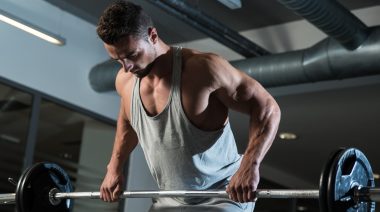Your abs may be under a layer or two of fat but the solution isn’t only in the kitchen. Yes, nutrition has a lot to do with how lean you can get and how quickly you can view your coveted abs, but the right training can move things along and will ensure a great-looking midsection waits on the other side of all that hard work.
Here are some ab workouts to get your midsection in shape while your diet does its job. Whether you’re training in a fully equipped gym or at home with the bare minimum, when it’s time to reveal your new look, you’ll have the shape and muscularity ready to show off.
Best Ab Workouts
Ab Workout in the Gym
Most commercial gyms are stocked with countless ab machines and other core training equipment. The options may seem overwhelming, but you can benefit from training your abs with a variety of angles for complete development.
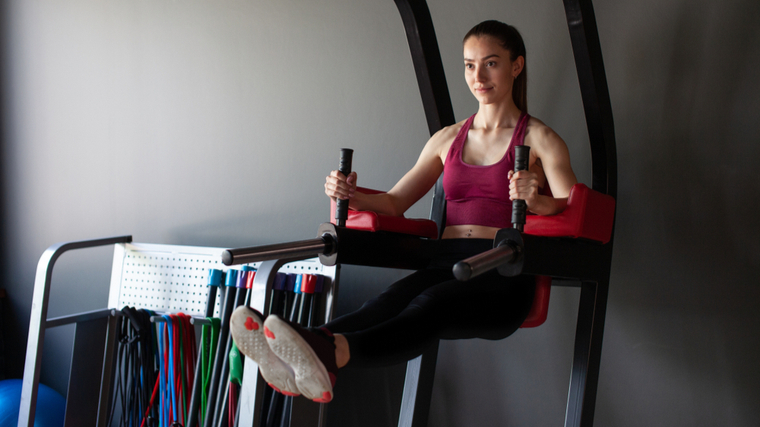
Instead of throwing in a few sets of simple crunches and calling it a day, hit your abs with a comprehensive plan to get well-rounded results from high-intensity training.
The Complete Ab Workout
Take advantage of some of the most common pieces of ab equipment found in a typical gym. Pay special attention to execution and treat your abs as you would any other body part. Too many lifters dismiss ab training as an afterthought and rush through exercises without focus or intensity.
Roman Chair Leg Raise
- How to Do It: Climb into a Roman chair (also known as a dip/chin station or hanging leg raise station) and support your bodyweight using the elbow pads with your upper body against the back pad. Tilt your pelvis forward slightly and bend your legs. The more your legs are bent, the less challenging the exercise; the more they’re straight, the more difficult the movement becomes. Raise your legs up until they are even with your waist before lowering them back down. Move slowly and use control throughout the entire rep.
- Sets and Reps: 3 x 10-15
- Rest Time: 30 seconds between sets.
Hyperextension Bench or GHD Sit-Up
- How to Do It: Sit “backwards” on a horizontal hyperextension bench or GHD (glute-ham developer), facing upwards with your shins fixed under the pads and your legs relatively straight. Cross your arms over your chest and keep them in place to avoid swinging for assistance. Lean back slowly until your torso is almost parallel with the floor and you’re facing the ceiling. Contract your abs to curl your upper body into an upright position.
- Sets and Reps: 3 x 15
- Rest Time: 20 seconds between sets.
Cable Woodchop
- How to Do It: Attach a single handle to a high cable pulley. Stand sideways to the handle and grab it with both hands. Keeping your arms slightly bent, bring the handle down and across your body until it’s at your waist on the opposite side. Slightly twist your torso and crunch down towards the handle using your obliques (side ab muscles). Slowly return to the starting position. Perform all reps for one side before flipping your stance to work the other side.
- Sets and Reps: 3 x 10 per side.
- Rest Time: None
Machine Crunch
- How to Do It: Sit in a crunch machine and grab the handles above your head. Focus on contracting your abs by bringing your ribcage and pelvis together. Pause in the crunched position and squeeze your abs before returning slowly to the starting position.
- Sets and Reps: 3 x 10-15
- Rest Time: 20 seconds between sets.
Ab Workout at Home
Even in the smallest home gym, there are plenty of ways to get an effective ab workout. Exercise balls and resistance bands are convenient, space-saving staples.
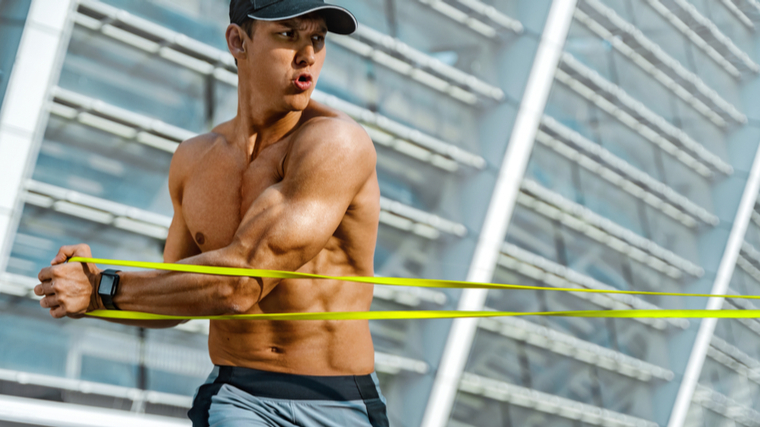
All it takes is some creativity to create a great program. While basic bodyweight exercises are one option, increasing the challenge using the most simple equipment can deliver better results.
The Home Gym Ab Workout
This simple and effective at-home workout uses just an exercise ball and resistance bands for a serious ab session. This lets you work the abs with more intensity than basic bodyweight exercises and without breaking the bank on any specialized equipment.
Banded Crunch
- How to Do It: Wrap the center of a resistance band around a stable object around waist-height. Lie on the floor in front of the band and hold both ends near your shoulders. With your legs bent and feet flat on the ground, crunch your upper body to pull the band. Hold the top position for one second before returning down slowly.
- Reps and Sets: 3 x 10
- Rest: 20 seconds between sets.
Exercise Ball Leg Raise
- How to Do It: Lie on the floor with your arms flat and your hands next to your hips. Squeeze an exercise ball between your feet and calves. Lift your legs to raise the ball up and over your pelvis, then lower it close to the floor. Don’t allow the ball to touch the floor until the entire set is completed.
- Sets and Reps: 3 x 10
- Rest: 20 seconds between sets.
Banded Twist
- How to Do It: Secure a band to a stable, upright object around waist-height (heavy table, chest or dresser, etc.). Stand sideways to the band and grasp it, keeping your elbows by your sides bent at 90-degrees. With your hips and feet stationary, “pull” the band by twisting your upper body while actively contracting your obliques and abs for stability. Return to the starting position. Repeat all reps for one side before switching.
- Sets and Reps: 3 x 10 per side.
- Rest: None
Ab Workout for Functional Strength
Crunches and sit-ups are great for ab development, but they aren’t the only tools to use. Some lifters and athletes can benefit from more “functional” ab training — which translates to fewer static movements and more exercises that engage the core in motion. (1)
This requires a more “total-body” approach to training your abs. It not only will be a unique training experience, it’ll also force you to adapt to various angles not achieved through traditional strength training methods.
The Athlete’s Ab Workout
For a functional ab workout, you may need to shift your mindset on how to perform some of these movements. You’ll be coordinating stability, balance, and explosiveness to stimulate your abs in new and different ways.
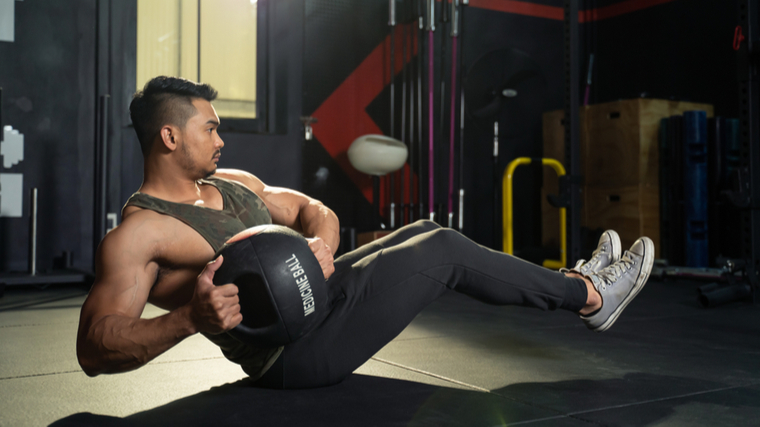
This approach to ab training involves more than just your abs, which helps to carryover to strength in other exercises, while building a stronger complete core.
Plank
- How to Do It: Lie on the floor face-down, supporting your body on your elbows and toes. Maintain a straight line from your feet to your shoulders. Contract your abs and stabilize your entire midsection. Hold this position and maintain head-to-to tension for the duration of the exercise.
- Sets and Reps: Three sets of 30 seconds per set.
- Rest: 30 seconds between sets.
Medicine Ball Sit-Up Throw
- How to Do It: Sit on the ground in the top of a sit-up position with your knees bent, feet flat on the floor, and your upper body near your thighs. Have a partner stand two to three steps away holding a light medicine ball. Have them gently throw you the medicine ball. Catch the ball at chest-level, lower your upper body to the floor, and immediately reverse direction, coming up to toss the ball back to your partner.
- Sets and Reps: 3 x 8
- Rest: 30 seconds between sets.
Russian Twist
- How to Do It: Take a medicine ball and assume a sit-up position. Straighten your legs and pick your feet off the floor. Only your glutes should be touching the ground. Twist your upper body from side to side, touching the ball to the floor on repetition.
- Sets and Reps: 3 x 20 touches to the floor (10 per side).
- Rest: 60 seconds between sets.
Bodyweight Ab Workout
The great thing about ab workouts, unlike many other body parts, is that they’re easy to adapt to wherever you end up and can be done anywhere, anytime.
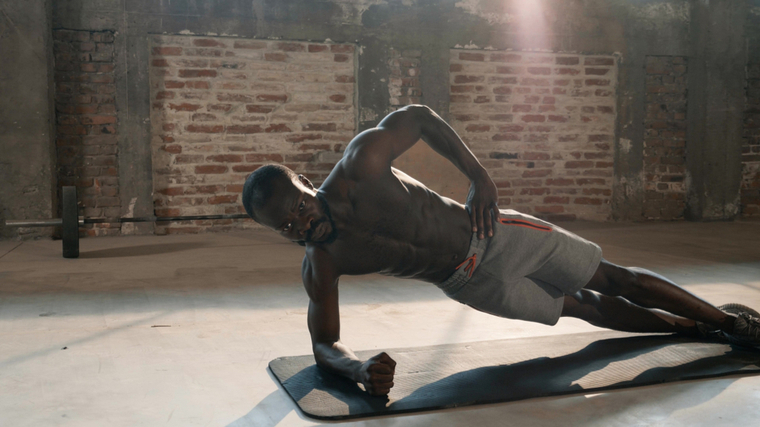
If you’re home, on the road, or even in the office, an ab workout is only limited by your imagination. You can get a lot done with no equipment.
The Bodyweight-Only Ab Workout
Some equipment can be useful, but you don’t need any “stuff” to get a good ab workout. The plan below allows you to train your abs directly and effectively wherever you may be.
Floor Crunch
- How to Do It: Lie on the floor with your knees bent at 90-degrees and feet flat on the floor. Cross your arms over your chest and slightly tuck your chin. Raise your upper body while keeping your lower back in contact with the floor. Squeeze at the top and then slowly return to the starting position.
- Sets and Reps: 3 x 20
- Rest: 30 seconds between sets.
Partial Lying Leg Raise
- How to Do It: Lie on the floor and place your hands flat under your glutes to relieve pressure from your lower back. Keep a slight bend in your knees while slowly raising your legs up until they are about 45-degrees from the floor (roughly halfway to a vertical position). Slowly return to the starting position.
- Sets and Reps: 3 x 20
- Rest: 30 seconds between sets.
Three-Way Plank
- How to Do It: Begin on the ground supporting your body on your elbows, forearms, and toes. Maintain a straight body position without sinking or arching your lower back. Hold for 20 seconds. Rotate to one side by shifting your weight to one shoulder and forearm and stacking your feet on top of each other. Don’t allow your hips to sink down. Hold the position for 20 seconds before rotating to the opposite side and holding for 20 seconds. Holding each position — center, one side, and opposite side — completes “one rep.”
- Sets and Reps: 3 sets of one rep.
- Rest: 30 seconds between sets.
Muscles of Your Abs
The abdominals are more than just the “six-pack abs” you might hope to see in the mirror. They consist of a group of muscles, some visible and some equally important below the surface. It’s important to know that the actual “six-pack” separation is determined by fibrous tissues, not any actual muscles, and they can’t be specifically trained.
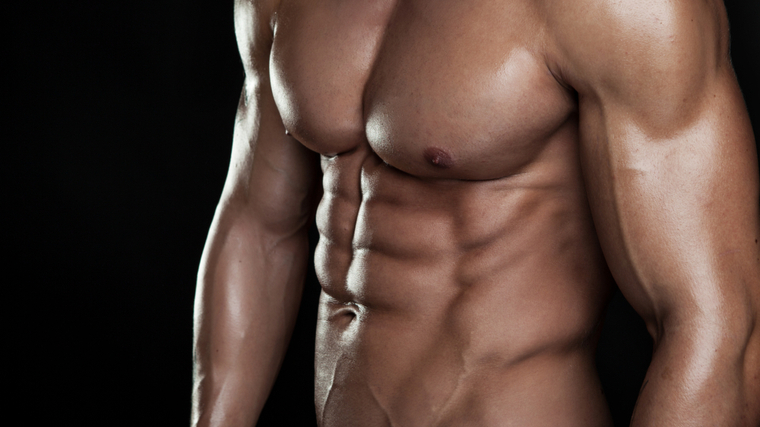
This is why, no matter what exercises or diet are used, some people may not be anatomically capable of building six or eight separate abdominals. Regardless, hard training and a cleaned-up diet can help reveal how your own abs will look.
Rectus Abdominis
This muscle group is best known as the coveted six-pack (or eight-pack, if your genetics allow it) that plenty of people desire. It originates from your ribs to the front of your pelvis. It helps keep your body stable and brings your ribs and pelvis closer when contracted, like during the classic ab crunch or sit-up exercise.
Transverse Abdominis
This muscle is found underneath the rectus abdominis and helps to stabilize the trunk. It’s an important postural muscle working to provide tension, stability, and support for the upper body. They also help to maintain internal abdominal pressure, which offers support for the spine.
External Obliques
This pair of muscles sit on each side of your rectus abdominus, above the hips. They run from the sides of your body towards your midline, working to rotate your trunk and “crunch” sideways, as well as stabilize your body during those types of twisting movements.
Internal Obliques
This pair of muscles sit below the external obliques and also sit on the sides of your rectus abdominis. They also help rotate and twist your trunk, flex or “crunch” sideways, and provide overall stability.
All About Abs
Whether you have little to no equipment or you’re training at a traditional gym, hitting your abs is possible wherever you are, no matter your goal. All it takes is some discipline, organization, and a consistency. Follow these workouts and you’ll improve your abs in no time. But if you really want to see them shine, you’ll still need to clean up your diet.
References
- Kibler, W. B., Press, J., & Sciascia, A. (2006). The role of core stability in athletic function. Sports medicine (Auckland, N.Z.), 36(3), 189–198. https://doi.org/10.2165/00007256-200636030-00001
Featured Image: Hananeko_Studio / Shutterstock




